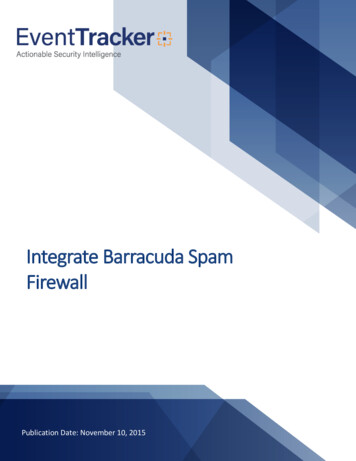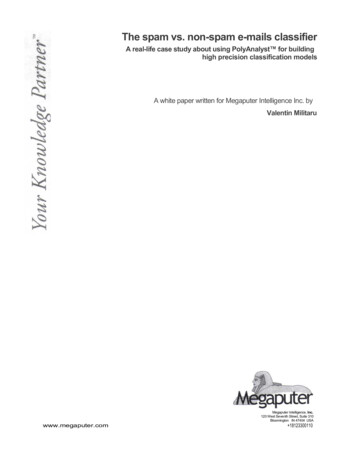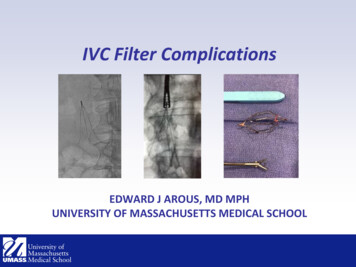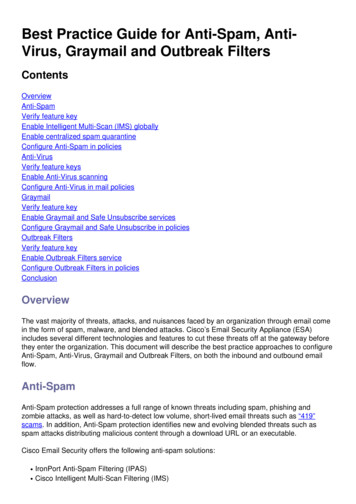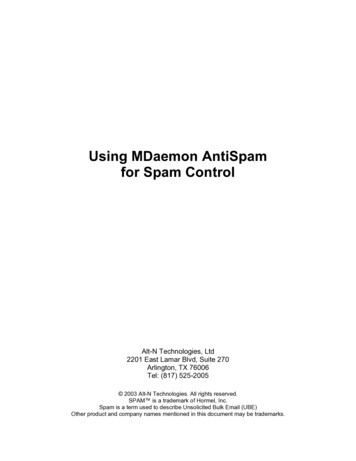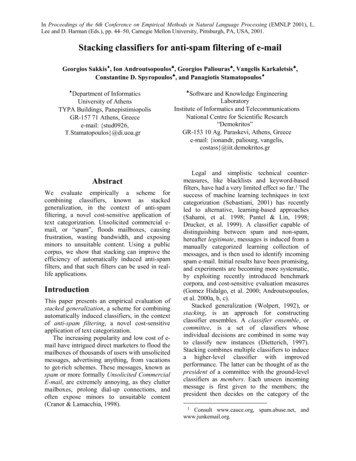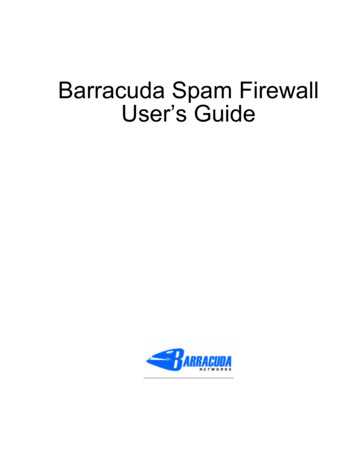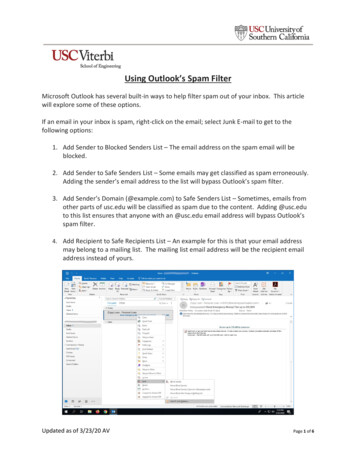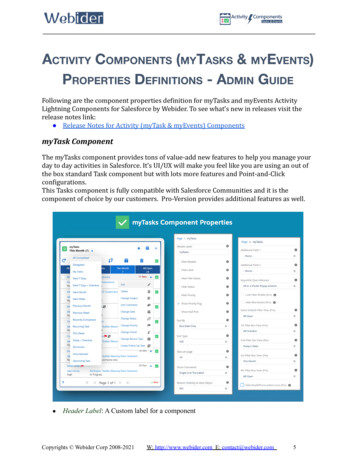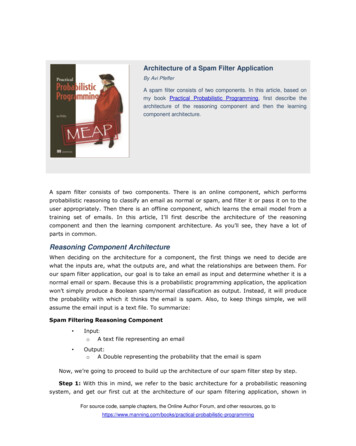
Transcription
Architecture of a Spam Filter ApplicationBy Avi PfefferA spam filter consists of two components. In this article, based onmy book Practical Probabilistic Programming, first describe thearchitecture of the reasoning component and then the learningcomponent architecture.A spam filter consists of two components. There is an online component, which performsprobabilistic reasoning to classify an email as normal or spam, and filter it or pass it on to theuser appropriately. Then there is an offline component, which learns the email model from atraining set of emails. In this article, I’ll first describe the architecture of the reasoningcomponent and then the learning component architecture. As you’ll see, they have a lot ofparts in common.Reasoning Component ArchitectureWhen deciding on the architecture for a component, the first things we need to decide arewhat the inputs are, what the outputs are, and what the relationships are between them. Forour spam filter application, our goal is to take an email as input and determine whether it is anormal email or spam. Because this is a probabilistic programming application, the applicationwon’t simply produce a Boolean spam/normal classification as output. Instead, it will producethe probability with which it thinks the email is spam. Also, to keep things simple, we willassume the email input is a text file. To summarize:Spam Filtering Reasoning Component Input:o A text file representing an email Output:o A Double representing the probability that the email is spamNow, we’re going to proceed to build up the architecture of our spam filter step by step.Step 1: With this in mind, we refer to the basic architecture for a probabilistic reasoningsystem, and get our first cut at the architecture of our spam filtering application, shown inFor source code, sample chapters, the Online Author Forum, and other resources, go istic-programming
Figure 1. Our Spam Filter Reasoning Component is used to determine whether an email isnormal or spam. It takes as evidence the text of the email. The query is whether the email isspam. The answer it produces is the probability the email is spam.To get this answer, the reasoning component uses an Email Model and an InferenceAlgorithm. The Email Model is a probabilistic model that captures our general knowledge aboutemails, including both the properties of an email itself and whether or not the email is spam.The Inference Algorithm uses the model to answer the query of whether or not the email isspam given evidence.Figure 1: First cut at spam filter reasoning architecture. The spam filter uses an inference algorithmoperating on an email model to determine the probability an email is spam given the email text.Step 2: We want to represent our probabilistic model using a probabilistic program. InFigaro, a probabilistic program has elements in it. In Figaro, evidence is applied to individualelements as conditions or constraints. So, we need a way to turn our email text into evidencethat can be applied to individual elements in the model. In machine learning, the componentthat turns raw data into evidence about model elements is typically called a Feature Extractor.Those aspects of the data that are applied as evidence to the model are called features. So, asFigure 2 shows, the Feature Extractor takes the email text as input and turns it into a set ofemail features, which become the evidence for the Inference Algorithm.Also, this particular probabilistic reasoning application always answers the same query: Isthe email spam? So, we don’t need to make a query an input to the application. Therefore, wehave dropped the query from the architecture.For source code, sample chapters, the Online Author Forum, and other resources, go istic-programming
Figure 2: Second cut at spam filter reasoning architecture. We've added a feature extractor andremoved the query, since the query is always the same.Step 3: It’s time to take a closer look at the model. Figure 3 shows a refinement of thereasoning architecture that breaks up the model into three parts: the Process, which containsstructural knowledge programmed in by the model designer, the Parameters, which arelearned from the data, and auxiliary Knowledge that is not directly related to elements but isused for reasoning.Figure 3: Third cut at spam filter reasoning architecture. The model is broken out into Process,Parameters, and Knowledge. The Parameters and Knowledge come from learning.Creating a model takes skill, but in general, a probabilistic model has the same kinds ofconstituents in it. In general, the model contains five separate constituents: Templates defining which elements are in the model. For example, there will be anelement representing whether the email is spam, and there will be elementsrepresenting the presence of particular words in the email. Exactly which words theseare is not yet specified; that is part of the Knowledge, which is explained below. The dependencies between the elements, for example, that an element indicating theFor source code, sample chapters, the Online Author Forum, and other resources, go istic-programming
presence of a particular word depends on the element representing whether the emailis spam. In a probabilistic model, the direction of the dependencies is not necessarilythe direction of reasoning. You use the words to determine if the email is spam, but inthe model, you can think of the email sender as first deciding what kind of email tosend (“I’m going to send you a spam email”) and then deciding what words go in it. Wetypically model dependencies in the causal direction. Since the kind of the email causesthe words, the dependency goes from the element representing whether the email isspam to each of the words. The functional forms of these dependencies. The functional form of an elementindicates what type of element it is, such as an If, an atomic Binomial, or a compoundNormal. The functional form does not specify the actual parameters of the element. Forexample, the above dependency takes the form of an If with two Flips: if the email isspam, then the word “rich” is present with one probability, otherwise it is present withsome other probability. These first three constituents, which make up the Process in Figure 3, are what isassumed by the spam filter application to be known before learning. They are definedby the designer of the application. Together, they constitute the structure of the emailmodel. The numerical parameters of the model, which make up the Parameters in Figure 3. Forexample, the probability that an email is spam is one parameter. The probability thatthe word “rich” is present if the email is spam is another parameter, while theprobability “rich” is present if the email is not spam is a third parameter. The reasonthe Parameters are separated out from the Process is because the Parameters will belearned from training data. The Knowledge in Figure 3 represents auxiliary knowledge used in constructing themodel and applying evidence to it in a particular situation. I use this term for anythinglearned from the training data that isn’t specifically related to the elements, eters.Inourspamfilterapplication, this knowledge will consist of a dictionary of the words that appeared in thetraining emails along with the number of times each word appeared. For example, weneed the Knowledge to tell us that the word “rich” is one we’re interested in. As aresult, the Knowledge helps define what the parameters of the model actually are; theprobability “rich” appears if the email is spam is only a parameter if “rich” is a wordwe’re interested in.At this point, the architecture of the reasoning component is fairly complete. It’s time tolook at the learning component.Learning Component ArchitectureWe know that the job of the learning component is to produce the email model used by thereasoning component given a dataset of emails. Just like we did for reasoning, the first thingFor source code, sample chapters, the Online Author Forum, and other resources, go istic-programming
to do is decide what the inputs and outputs of the learning component are. Looking at Figure3, we know that the output needs to be the Parameters and Knowledge of the email model.But what about the input? We can assume that we’re given a training set of emails from whichto learn, so that makes up part of the input. But learning is much easier if someone has alsolabeled some of those emails as normal or spam. We’re going to assume that we are given atraining set of emails, as well as labels for some of those emails.However, not all the emails have to be labeled; we can use a large dataset of unlabeledemails in addition to a smaller dataset of emails with labels.Spam Filtering Learning Component Inputs:oA set of text files representing emailsoA file with normal/spam labels for a subset of the emailsOutput:o essoAuxiliary knowledge to use in the modelFigure 4 shows the architecture of the spam filter learning component. It uses manysimilar elements to the reasoning component, but with some important differences: The learning component centers on a Prior Email Model. This model contains the sameparts as the Email Model in the reasoning component, except that we use PriorParameters for the parameters instead of parameters produced by the learningcomponent. Prior parameters are the parameters of your model before you’ve seen anydata. Since the learning component has not seen any data before it operates, it usesprior parameter values. The other two parts of the model, the Process and theKnowledge, are exactly the same as for the reasoning component. The Knowledge itself is extracted directly from the training emails by a KnowledgeExtractor. For example, the Knowledge might consist of the most common wordsappearing in the emails. This Knowledge is also output from the learning componentand sent to the reasoning component. Just like in the reasoning component, the Feature Extractor extracts features of all theemails and turns them into evidence. The normal/spam labels are turned into evidencefor the emails for which we have labels. Instead of an inference algorithm, we have a Learning Algorithm. This algorithm takesall the evidence about all the emails, and uses the model to learn parameter values.Like reasoning algorithms, Figaro provides a number of learning algorithms.For source code, sample chapters, the Online Author Forum, and other resources, go istic-programming
Figure 4: Learning component architectureThose are all the pieces of the learning component. One of the nice things about ourarchitecture, with its division into reasoning and learning components, is that the learningcomponent can be run once and the results can be used many times by the reasoningcomponent. Learning from training data can be a time consuming operation, and we wouldn’twant to do it every time we want to reason about a new email. Our design allows us to do thelearning once, export the learned parameters and knowledge, and use them to reason rapidlyabout incoming emails.For source code, sample chapters, the Online Author Forum, and other resources, go istic-programming
Spam Filtering Reasoning Component Input: o A text file representing an email Output: o A Double representing the probability that the email is spam Now, we're going to proceed to build up the architecture of our spam filter step by step. Step 1: With this in mind, we refer to the basic architecture for a probabilistic reasoning
